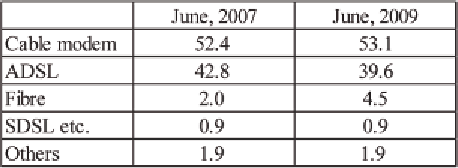Information Technology Reference
In-Depth Information
Table 2. Broadband shares by technology in the U.S.A (Source: Calculated from FCC (2010)).
modem is 53.1% if we exclude cellular that is not
regarded as broadband in many other countries.
The development of facilities based competi-
tion between cable modem and ADSL is explained
by the asymmetric regulation between cable mo-
dem and ADSL. Although cable tariffs were
regulated by the Cable Competition Act of 1992,
new services offered over cable networks such as
cable modem or VOIP are not regulated. Cable
operators are not only free from an unbundling
obligation but also from an 'open access' obliga-
tion. They can bundle their own ISP services with
cable modem. Further, MSOs have long been
authorised in the cable industry in the U.S.A. Big
MSOs have been able to invest in cable modem
facilities due to abundant financial resources.
In the case of ADSL, the FCC rule based on the
Telecommunications Act of 1996 (FCC (1996))
imposed an unbundling obligation on LECs. LECs
sued several times against the FCC rules and the
FCC was obliged to review the rule, whenever it
was ordered to suspend the rules. The litigations
were settled finally by the new rules of the FCC
6
.
Although the FCC maintained the unbundling
obligation on copper loops, other unbundling
obligations were greatly relaxed.
Further, the FCC ruled that ADSL was included
as an 'information service' in order to maintain
consistency with its rule that cable modem is
'information service' (FCC (2005)). Owing to
the revision, ADSL can compete under the same
conditions as cable modem and LECs have started
to invest in ADSL facilities. Facilities based com-
petition between cable modem and ADSL has
started to develop. As a result, the discussions on
structural separation of LECs have ended. On the
contrary, it seems that the FCC has given up its
structural separation policy as mentioned in the
former section. Vertical integration has progressed
through its authorisation of the mergers between
SBC and AT&T and between Verizon and MCI.
The main objective of structural separation is to
prevent the abuse of market power of a dominant
firm in the upstream market toward the down-
stream market. The progress of facilities based
competition in the broadband market means that
the bottleneck nature of the access facilities of
LECs is phased out. LECs no more hold market
power in the upstream market and the possibil-
ity of the abuse of market power disappears as
shown in Figure 1. It is not necessary any more to
introduce structural separation. As the competition
between LECs and cable operators in broadband
access services has progressed in the U.S.A., the
discussions on structural separation have become
low profile and the mergers between RBOCS and
long-distance carriers were approved.
Here it is important to notice that this is the
result of the FCC regulation that allowed the
formation of big MSOs (Multiple System Opera-
tors) with strong financial resources and induced
the investment in cable modem facilities by the
a) Although the Line-sharing obligation for ex-
isting CLECs (Competitive Local Exchange
Carriers)' customers was maintained, the
obligation for new customers were to be
gradually relaxed and will be abolished after
3years.
b) The Unbundling obligation of FTTx loops
was abolished except for 64 kbs voice grade
passes.

Search WWH ::

Custom Search